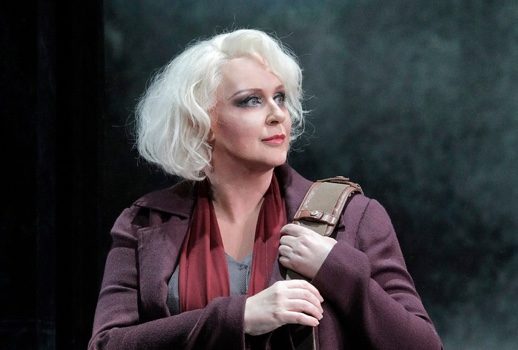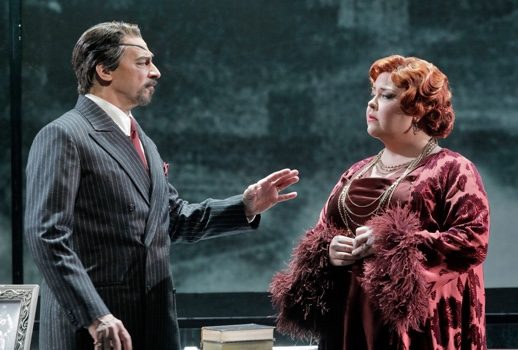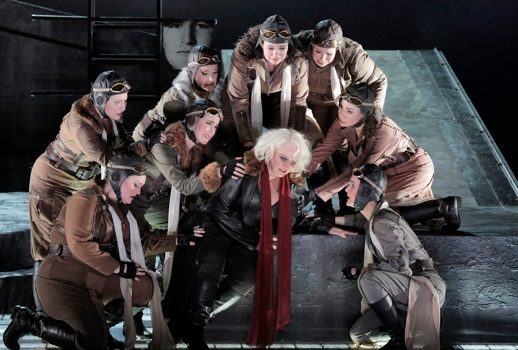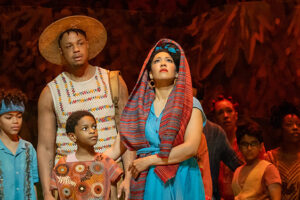

“Radiant and spunky” Iréne Theorin
If Das Rheingold is an opera about infinitude, the illusory idea that the world is large enough to satisfy all of our desires, passions, and lusts, Die Walküre is an opera about scarcity.
Not just scarcity of natural resources but, more importantly, human resources. In Das Rheingold, the gods can steal from one another without consequence, build palaces they can’t afford, and make promises they can’t keep. Even when Alberich loses all he has built at Wotan’s hands, he is no worse off than when he started.
In Die Walküre, consonance and harmony give way to contradiction and discord: contradiction between Wotan’s commitments to his wife and to his son; between Sieglinde’s heart and her marriage; between Siegmund’s mortal love and his divine lineage. And in Wagner’s most grotesque dramatization of all, Wotan’s physical self and his will are agonizingly split apart, the latter coming to rest in the heart of his daughter Brünnhilde, surrounded by an impregnable wall of flame.
By the end of Die Walküre, we understand for the first time the true nature of Alberich’s curse: with greed and jealousy invariably come limitation and scarcity. For the first time, the gods see their divinity eroding beneath their feet.
Francesca Zambello’s production chooses (as it did seven years ago) to portray this newfound scarcity through environmental degradation. Even in the opening sequence of Act 1, which situates us in the wilderness surrounding Hunding’s hut, we see dizzying projections of a forest as filmed through the camera of a drunken (or severely impaired) photographer.
We know right away that the pristine wilderness setting has a short time yet to survive. And indeed, Siegmund and Hunding’s Act 2 duel takes place below a highway overpass amid heaps of garbage and discarded car parts. (And to think I didn’t even know that Wagner had ever been to West Oakland!) The setting of the overpass is—if past Zambello productions are any guide—a preview of the despoiled dystopia we will see in Götterdämerung on Sunday.
Although Zambello’s program notes indicate that she does earnestly read the Ring at least in part as a piece about environmental despoilment, I find it rather more profound to see her highly effective settings not as Sierra Club advertisements, but as metaphor. Environmental scarcity serves as a mirror of the advancing vulnerability of the gods themselves.
Walküre’s staging showed a profoundly developed aesthetic sense and a flair (often literally) for the dramatic. The staging of Act 1 was truly a work of art —a lonely clapboard house in the wilderness with a small fire in front, which opens to reveal a hunting lodge that (save for Hunding’s various torture devices) would have made TR and the Roughriders proud, which itself opens to reveal a full moon and twilit sky as Siegmund and Sieglinde profess their love.
Wotan’s court in Valhalla is a corporate boardroom with a massively long black marble table and a silhouette of a smog-obscured city skyline behind it; the mountaintop of the Valkyries’ return and Brünnhilde’s fiery imprisonment (surrounded by real fire) looked like a helipad on a military base. Though all of these settings were spectacular, there was a certain disconnect between the forest hut staging of Act 1 and the “late-stage capitalism” settings of the other acts. Perhaps Zambello’s Hunding should have lived in an urban slum!

Each of the four main vocal roles—Wotan, Brünnhilde, Siegmund, and Sieglinde, need both to be able to sustain intensity and postpone resolution over prolonged periods of time. They also must have a top gear of expressive intensity and projection that they unleash only for the greatest climaxes. And even the best singers can only negotiate this minefield with a skilled hand on the wheel in the orchestra pit.
Over the first two Ring operas, Donald Runnicles’ leadership has been excellent. In his gestures, he gives just the right amount of space and suppleness for phrases to have some internal life and unpredictability, while still not shy about moving the music forward. Frequently, opera conductors pay too much attention to the stage, allowing things in the pit to simply work themselves out.
Runnicles has evinced a special talent, however, for identifying the instances in which Wagner uses soloistic devices in the orchestra in a humanoid manner. Through gesture, he passes musical energy from the instrumentalists in the pit to the stage, revealing Wagner’s use of leitmotivs in the orchestra frequently to be figments of the singers’ subconscious.
For the orchestra, the primary challenge of playing Wagner in the pit is mental endurance. It’s about maintaining the will to play each sustained chord in the brass or woodwinds with reverent care, making minute adjustments to the intonation as the chord evolves, and paying just as much attention to the seventeenth such sustained chord in a row as to the first; militantly matching articulation across a section; reenergizing each diminished string tremolo with edge-of-seat vitality; saving expressive intensity for the exact moment of release.
Playing this way is so difficult because it’s mostly thankless—credit for a perfectly calibrated climax goes to the singer, maybe the conductor, but rarely the supporting musicians in the pit.
In Die Walküre, Runnicles’ orchestra was at its strongest in the first act. Wagner’s sumptuous string textures as Siegmund and Sieglinde first meet had exactly the right amount of unfulfillable grasping. The prelude to the first act, an alternation of low string ostinati and rumbles from the low brass and timpani, had an almost Sibelian breadth.

But even as individuals in Runnicles’ orchestra seemed both aware of and invested in their dramatic roles, there were several instances (particularly later on in the opera) where Wagnerian fatigue and ensemble complacency seemed to set in. At the conclusion of the first act (in which Wagner pre-composes Strauss’ Don Juan), the triple-tongued woodwind accompaniment figures gradually lost some precision and ensemble.
During Brünnhilde’s Act 2 visitation of Siegmund under the overpass, intonation started to suffer in some of the sustained brass chords (giving the audience several seconds to notice something was amiss). And in Act 3’s reconciliation between Wotan and Brünnhilde, the accompanying woodwind intonation, as well as the togetherness of lower strings on the funereal drumroll figures, began to take on a “good enough” ambivalence.
Runnicles and the orchestra were quite successful overall with maintaining motion, allowing only a few brief periods (particularly during Siegmund’s life story in Act 1, and Siegmund and Sieglinde’s Act 2 argument) where the tempo seemed to drag. But it was those many moments of perfect coordination in phrase motion and direction between stage and pit that made this rendering of Walkure so effective.
One of the most successful singers onstage at mastering this sense of motion and pacing was tenor Brandon Jovanovich who, after offering a tantalizing sample of his cello-like tone as Froh in Das Rheingold, returned as Siegmund yesterday. Throughout, he demonstrated a clear sense of the long phrase, whether spinning a wonderfully bitter tale of his childhood woes for Sieglinde and Hunding, or rising to expressive peak after peak as “love and spring” were united at the conclusion of the act.
Jovanovich dwelled on his text almost lovingly: as he described the death of the defenseless daughter he had tried to protect, he somehow managed to draw out the “d” of “tod” to last longer than the rest of the word. He showed an ability to project even over Wagner’s most daunting brass tuttis, managing to combine warmth and incisiveness in an embracing sound, making it easy to imagine why Brünnhilde would have been persuaded to ignore her father’s will and take his side.
His only less than persuasive moment was during the funeral march when Brünnhilde tries to prevail upon him to go with her to Valhalla. In this one instance Jovanovich demonstrated a somewhat pinched, strained sound. But perhaps in such a strained moment, that was his intent.
A more than worthy match for Jovanovich and very pleasant surprise was the Finnish soprano Karita Mattila as Sieglinde. More than any other singer last night, she showed an intuitive unity with Runnicles and the orchestra—an ability both to lead her accompanist and interact with the pit.

Slightly less convincing (though probably more Wagner’s fault than hers) was her instantaneous transition, upon getting the news that she was carrying Siegmund’s child, from trying to stab herself to begging for salvation.
In the role of Brünnhilde, Iréne Theorin was radiant and spunky. From her first appearance in the second act, dressed the part of a hipster barista, she brilliantly embodied her character’s childlike wisdom, irrepressible energy, and deep, spiritual attachment to her father. Through the rest of the opera, she grew up before our eyes, from self-satisfied Valkyrie to tragic heroine.
In both her singing and stage acting, this gradual maturation showed itself in a transition from an overeager, chirpy persona to a far deeper, more thoughtful one. Musically she was somewhat more at home with the vocal acrobatics of her Valkyrie-cry-laden Act 2 entrance than the deeper, more subdued sound world of Act 3, but I look forward to seeing her development through the last two installments.
One of the great joys of last night’s performance was the shift in Greer Grimsley’s Wotan from the waiflike playboy of Das Rheingold into an independent and, yes, willful tragic hero. Unfortunately, we saw little fury from Grimsley following his realization of Brünnhilde’s betrayal, making the end of Act 2 somewhat disappointing.
However two particularly poignant scenes demonstrated a far wider expressive breadth. In his deeply ashamed admission to Brünnhilde that he needed her to change her allegiances from Siegmund to Hunding, Grimsley’s tone blossomed into the bottom part of his range, showing an ability to shape phrases within a muted dynamic and dark sound world.
And in his eulogy for Brünnhilde’s divinity at the conclusion of Act 3, he mustered his most supple and lyrical sound of the cycle thus far. It seems somewhat ironic that as Wotan the character has become more helpless, more boxed in, Grimsley’s portrayal of him has increasingly opened up. Or perhaps this is a part of exactly the sort of transition from divinity to humanity Wagner intended.
In last night’s performance, Jamie Barton’s Fricka became a more formidable force, emasculating the hypocritical Wotan to the point of tears. She clearly reveled in Wotan’s misery, each wave of accusations bringing out of Barton a more steely tone and more cutting consonants.
And Raymond Aceto in the role of Hunding was perfectly terrifying, roughly grasping Sieglinde with each scornful command and projecting over Wagner’s thick bass and low brass doublings. Brünnhilde’s sisters, in their Act 3 return to Valhalla in paratrooper uniforms, embodied the irrepressible youth of their roles.
Die Walküre, the opera in which Alberich’s curse strips the gods of their divinity, offers a more receptive vessel for Zambello’s human approach to The Ring than did Das Rheingold. Across the board, the singers and orchestra rose to the challenge of a more expressive and human opera.
We will have one day of rest (thank goodness) and be back with Siegfried in two days.
Photos: Cory Weaver / San Francisco Opera























Comments